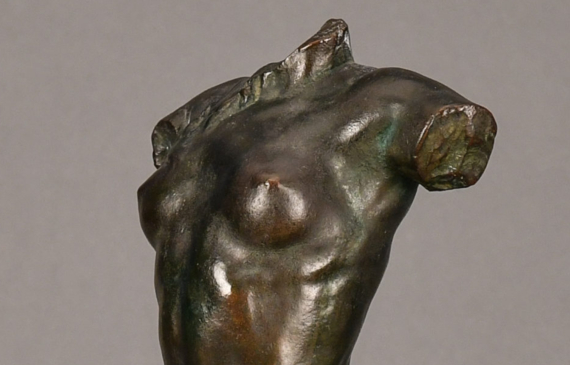







Paul W. Bartlett (American, 1865–1925)
Seated Female Torso, 1895
Bronze with blackish-brown patina with rich green highlights on base
13 1/4 H. inches
Signed on base: Bartlett











Paul W. Bartlett (American, 1865–1925)
Sculpin Fish, 1896
Bronze, 4 3/4 H. x 10 W. inches
Signed on base: PWB ’96
Stamped on base: SF
Paul Wayland Bartlett was born in the United States in New Haven, Connecticut, in 1865. His father was Truman H. Bartlett, a well known sculptor, critic and teacher at the time. Bartlett moved to Paris, France with his mother in 1874 at the age of nine, as his father did not want him educated in the United States. Having often watched his father sculpt, Bartlett followed in the patriarch’s footsteps. Paul was only fourteen when he exhibited his first work at the Paris Salon of 1879, a bust of his grandmother. Bartlett was fifteen when he entered the École des Beaux Arts and studied with the sculptor Pierre Jules Cavelier. He then also took classes at the Jardin des Plantes under animal sculptor Emmanuel Frémiet, as animal sculpture was very popular among Frenchmen. Soon Bartlett was employed by Georges Gardet, an animal specialist, to help with modeling animals required for statues by other artists. He also often helped as an assistant in Auguste Rodin’s studio.
In 1899, after Bartlett was an established sculptor in the United States and France, he was awarded the commission to create a sculpture of the Marquis of Lafayette. The statue was to be given by the Untied States government to the French nation as a reciprocal gift for the Statue of Liberty. It wasn’t until 1908 that the bronze cast was finally set in place in the Louvre Garden, although a plaster model had been unveiled in 1900.
Bartlett came to the attention of critics and collectors with his first large group work he showed in the Salon in 1887 titled Bohemian Bear Tamer. It was the plaster model which Bartlett showed at the Paris Salon of 1887, after which the work was cast in bronze and exhibited again at the Paris Salon of 1888. The sculpture won honorable mention at the Salon of 1887 and Grand Prix for sculpture at the 1889 Paris Exposition Universelle. The plaster model also made its way to the United States and was displayed in 1893 at the World’s Columbian Exposition in Chicago.